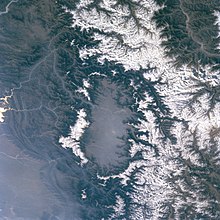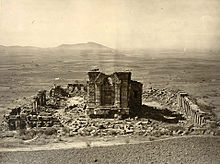Kashmir Valley
This is the sighted version that was marked on August 24, 2020. There are 3 pending changes that still need to be sighted.
Kashmir (Urdu وادی کشمیر; Hindi कश्मीर घाटी) or Kashmir Valley is a valley and division between the Karakoram and the Pir Panjal in the Indian Union Territory of Jammu and Kashmir. No part of the valley is currently administered by Pakistan, but it is entirely under Indian administration. The valley is about 135 km long and 32 km wide and was formed by the Jhelam. Kashmir is one of the two divisions of Jammu and Kashmir along with Jammu. The division is divided into the districts of Anantnag, Baramulla, Budgam, Bandipore, Ganderbal, Kupwara, Kulgam, Pulwama, Shopian and Srinagar.
According to the Vedas, the Kashmir valley was once a great lake called Satisaras Sati or Parvati after the consort of Shiva. The lake was drained by the Naga leader Ananta (the district of Anantnag is named after him) and became Kash-mira after his father the Rishi-Kashyapa. The Mughal ruler Jahangir called it paradise on earth.
Geography
The Kashmir Valley borders the Jammu Division to the south and the Union Territory of Ladakh to the east and the Line of Control to the north and west.
Climate
The Kashmir Valley has a temperate climate. The climate can be characterized as cool in spring and autumn, mild in summer and cold in winter. The size of the valley means that there is often different weather in the mountainous areas than in the lower, flat parts.
Summer is generally moderately warm with little rain, but high relative humidity and cool nights. Rainfall occurs throughout the year and no month is particularly dry. The warmest month is July with an average low temperature of 6 °C and an average high temperature of 32 °C. The coldest months are December and January with an average low of -15 °C and an average high of 0 °C.
Compared to other parts of India, the Kashmir Valley has a temperate climate, but weather conditions are unpredictable.
The Kashmir Valley has experienced an increase in average humidity in recent years and average precipitation has also increased. This is attributed to major reforestation efforts.

The Kashmir Valley (centre) in a satellite photo. The snow-covered mountains separate it from the plains.
History
According to folk etymology, the name Kashmir means drained land. It comes from Sanskrit: Ka = water and shimeera = dry. In the Rajatarangini, history of Kashmir written by Kalhana in the mid 12th century, it is said that Kashmir used to be a lake. According to Hindu mythology, the lake was drained by Rishi Kashyapa, son of Marichi, son of Brahma by opening a cut at Baramulla (Varahamula). After Kashmir was drained, Kashyapa induced Brahmins to settle there. The main town in the valley was called Kashyapa-pura, which appears as Kaspapyros in Hekatios of Miletus (after Stephanos of Byzantium) and as Kaspatyros in Herodotus (3.102, 4.44). Kashmir is also said to be the country which Ptolemy calls Kaspeiria.
In the first 500 years after Christ, the region of Kashmir was an important center of Hinduism and later Buddhism. In the 9th century, Kashmiri Shivaism emerged. In 1349, Shah Mir became the first Muslim ruler of Kashmir and founder of the Salatin-i-Kashmir or Swati dynasty. Over the next 500 years, Muslim rulers ruled Kashmir including the Mughals from 1526 to 1751 and the Afghan Durrani Empire from 1747 to 1820, when it was annexed by the Sikhs, under Ranjit Singh. In 1846, after the defeat of the Sikh in the First Sikh War and the acquisition of the region by the British in the Treaty of Amritsar, the Raja of Jammu, Gulab Singh, became the new ruler of Kashmir. This rule and that of his descendants lasted until 1947 when the princely state of British India became a disputed territory now administered by India, Pakistan and the People's Republic of China.
The Kashmir Valley is 15,948 sq km, which was 15.73% of the Indian-controlled area of the former state of Jammu and Kashmir.

General view of the temple and enclosure of Surya at Bhawan. Probably 490-555. photo taken by John Burke in 1868.
Search within the encyclopedia